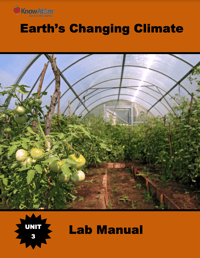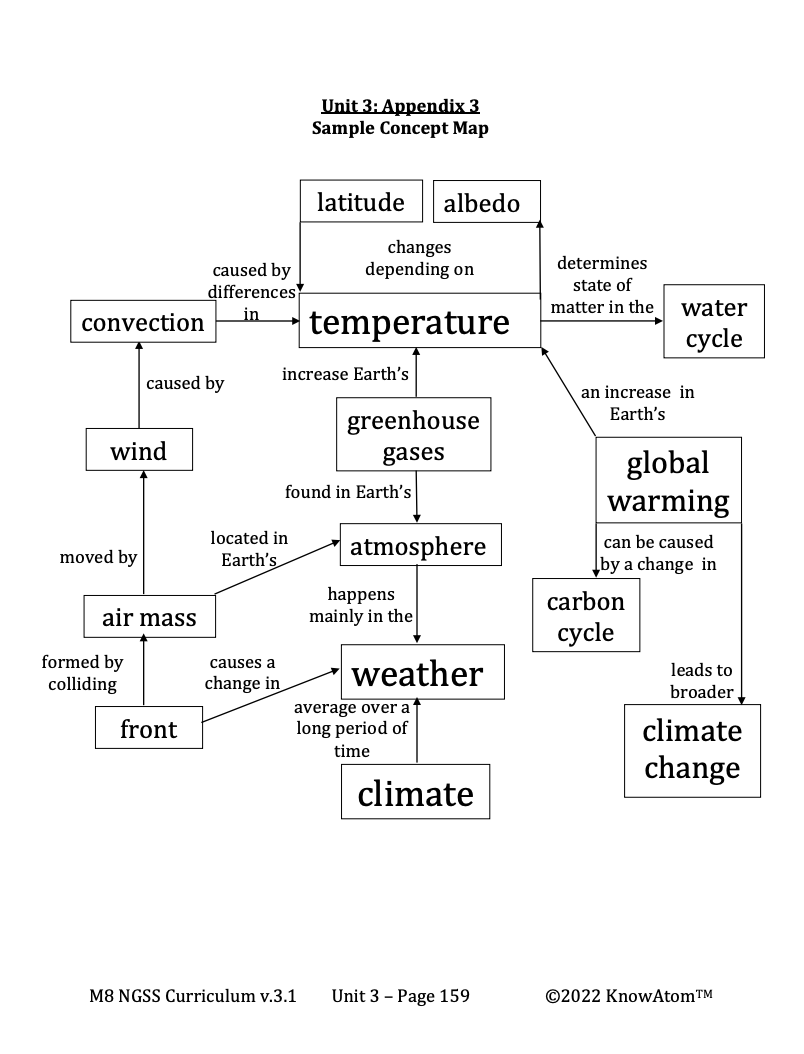Science background provides teachers with more in-depth information about the phenomena students explore. Below is an excerpt of the science background section on convection and weather phenomena.
Moving Air Masses
Air masses move with the global wind patterns. At the same time, the air masses move around the planet in an effort to redistribute the heat. The cold air masses move south toward warmer temperatures, while warm air masses move north toward cooler temperatures. However, the surface features of the land can cause an air mass to change its path. For example, air masses are often deflected when they collide with mountains.
As air masses move, they carry with them their temperature and moisture. However, as an air mass moves over Earth’s surface, the changing characteristics of the surface can change the air mass. For example, when a continental polar air mass moves over warm water, heat and moisture will transfer from the warm surface of the water to the air near the surface.
As air masses move, they can also collide with other air masses. The boundary between two air masses is called a front. When a front passes over a location, the weather in that location will change. Remember that warm air rises and cold air sinks. This behavior is true for air masses as well, and it is what causes the different kinds of fronts.
For example, a cold front occurs when a cold air mass replaces a warm air mass. When a cold air mass collides with a warm air mass, the cold air mass will sink underneath the warm air mass, pushing the warm air upwards. This happens very quickly because the cold air mass is so much denser than the warm air mass.
As a result, it pushes the warm air up into the atmosphere, where the warm air quickly loses heat to the atmosphere. This causes the water vapor in the atmosphere to cool off and condense, forming clouds and precipitation. Because of this, cold fronts often produce powerful storms. They are represented on a weather map by a solid blue line with triangles pointing in the direction of their movement. Temperatures in front of the cold front are warmer than temperatures behind it.
When a warm air mass replaces a cold air mass, it is called a warm front. When this happens, the warm air mass gradually moves over the cold air mass. Because this occurs much more slowly than a cold front, there aren’t usually strong storms associated with warm fronts. Instead, steady drizzle that lasts for a while is more common. Warm fronts are represented on a weather map by a solid red line with semicircles pointing in the direction of their movement. Temperatures in front of the warm front are cooler than temperatures behind it.
Sometimes when a warm air mass collides with a cold air mass, neither mass is powerful enough to move the other. The cold air mass pushes against the warm air mass, but the warm air mass pushes back equally. The result is a stationary front. This can result in clouds that can remain for days at a time. Eventually the front will either break apart or begin moving again. It turns into a warm front if the warm air moves forward, pushing the cold air. It turns into a cold front if the cold air mass moves forward instead.
The last kind of front is called an occluded front. This occurs when a cold front follows right behind a warm front. The warm front occurs when a warm air mass replaces a cold air mass. When another cold air mass pushes into the warm air mass, it is usually moving faster than the warm air mass. Because of this, the second cold air mass runs into the cooler air mass that was ahead of the warm front. The warm air is pushed up, and precipitation often occurs. An occluded front is represented with a purple line with half triangles and half semi circles along it pointing in the direction that the front is moving.
High and Low Pressure
Weather maps also often indicate high and low pressure systems. A high pressure system is noted with a blue “H,” and a low pressure system is noted with a red “L.”
A high pressure system has higher pressure at its center. Because of this, it is characterized by sunny and clear skies. This can be understood by thinking about heat transfer and the water cycle. The air in a high pressure system sinks down from above because air always moves from high pressure areas to low pressure areas. As it moves lower in the atmosphere, it becomes warmer and drier. The winds in a high pressure system blow clockwise in the northern hemisphere and counterclockwise in the southern hemisphere because of Earth’s rotation and the Coriolis effect.
A low pressure system has lower pressure at its center than the areas around it. It is characterized by clouds and precipitation. This is because warm air near Earth’s surface rises into the atmosphere. As it moves upward, it cools and condenses, forming clouds and precipitation. Winds in a low pressure system move opposite from a high pressure system. They move counterclockwise in the northern hemisphere and clockwise in the southern hemisphere.
Forecasting Weather
Scientists called meteorologists use powerful supercomputers to gather information about weather conditions around the planet. Because weather conditions in one location are affected by conditions in distant regions, there are thousands of weather stations positioned around the world, constantly gathering data about the weather. Weather stations include temperature sensors, wind gauges, and rain collectors. As a result of all of these stations, more than one million weather- related observations are made every single day.
Those calculations all feed into supercomputers that perform millions of calculations every second in an effort to predict weather conditions over time. It is these predictions that most weather channels and meteorologists around the country use in their weather forecasts.
And yet, despite the many weather stations around the world, weather forecasting remains an inexact science. A sudden storm can catch even the most diligent forecaster off guard. This is because even a small change to any one variable can have dramatic effects on Earth’s weather.
For example, forecasters have to predict how exactly the sun will heat each part of Earth’s surface, how that heat will influence the water cycle, how differences in air pressure will affect wind patterns, and how the planet’s rotation will affect the movement of air and water, among many other complicated variables and interactions.








